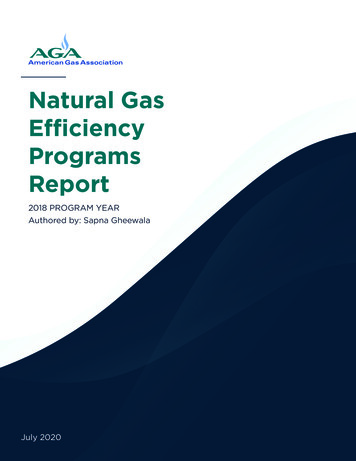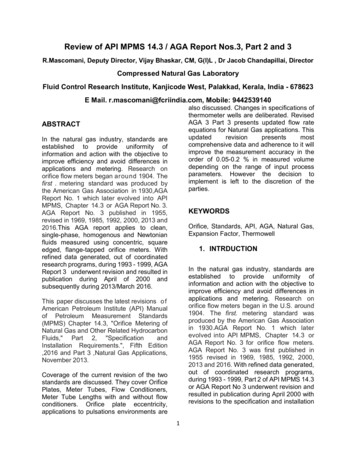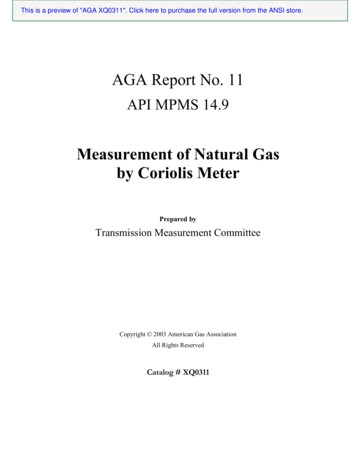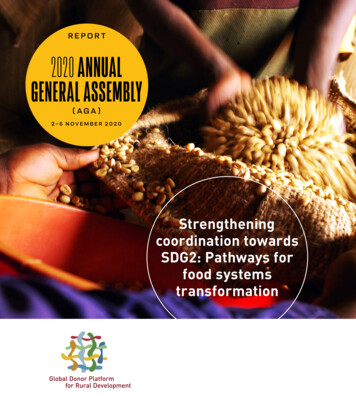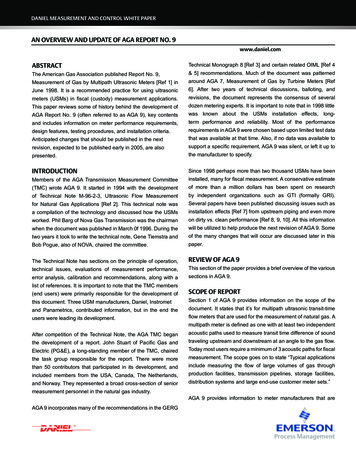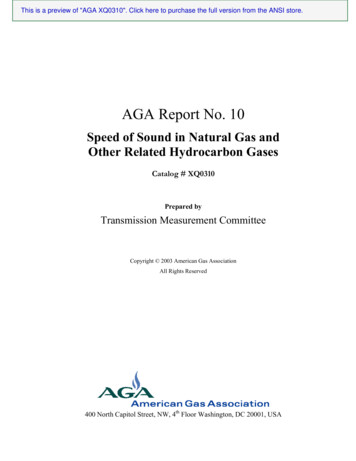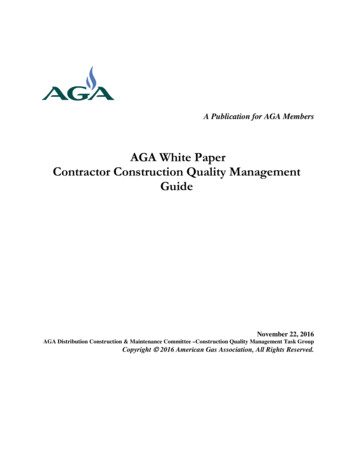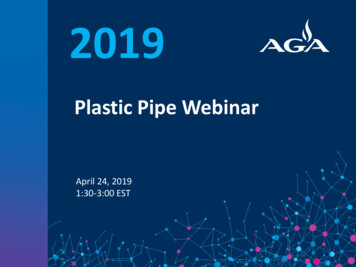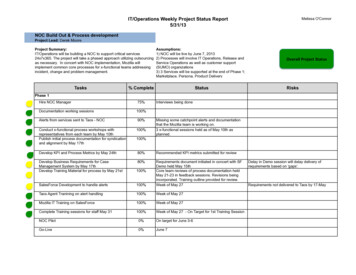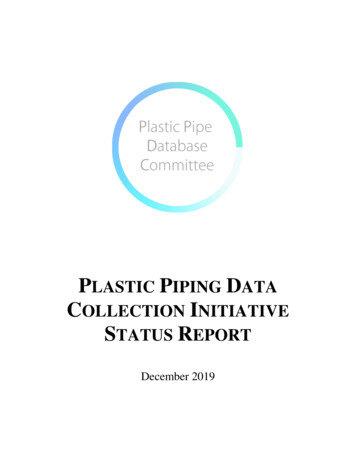
Transcription
PLASTIC PIPING DATACOLLECTION INITIATIVESTATUS REPORTDecember 2019
Copyright Plastic Pipe Database Committee 2019All Rights ReservedAdministered byAmerican Gas Association400 North Capitol Street, N.W., 4th FloorWashington, DC 20001U.S.A.NOTICE AND COPYRIGHTThe Plastic Pipe Database Committee (PPDC), composed of representatives of the American Gas Association(AGA), American Public Gas Association (APGA), Plastics Pipe Institute (PPI), National Association ofRegulatory Utility Commissioners (NARUC), National Association of Pipeline Safety Representatives (NAPSR),National Transportation Safety Board (NTSB) and U.S. Department of Transportation’s (DOT) Pipeline andHazardous Materials Safety Administration (PHMSA), coordinates the creation and maintenance of a database(“PPDC Database”) to proactively monitor the performance of plastic pipe and metal and/or plasticappurtenances contained within plastic piping systems. While AGA provides administrative services to thePPDC, it does not independently test, evaluate, or verify the accuracy or soundness of any statements containedin the PPDC database or made by the PPDC.This document is based on information from the database that has not been verified or audited. The PPDCand the AGA disclaim liability for any personal injury, property or other damages of any nature whatsoever,whether special, indirect, consequential or compensatory, directly or indirectly resulting from the publication,use of, or reliance on this document. The PPDC and the AGA also make no representation, warranty orguarantee in connection with this document, including, the accuracy or completeness of the information therein.Nothing contained in this document should be viewed as an endorsement or disapproval of any particularmanufacturer or product.In issuing and making this document available, the PPDC and the AGA are not undertaking to renderprofessional or other services for or on behalf of any person or entity. Nor are the PPDC and the AGAundertaking to perform any duty owed by any person or entity to someone else. Anyone using this documentshould rely on his or her own independent judgment or, as appropriate, seek the advice of a competentprofessional in determining the exercise of reasonable care in any given circumstances.Users of this document should consult applicable federal, state and local laws and regulations. The PPDCand the AGA do not, by the publication of this document, intend to urge action that is not in compliance withapplicable laws, and this document may not be construed as doing so.Information concerning safety and health risks, proper installation or use, performance or fitness or suitabilityfor any purpose with respect to particular products or materials should be obtained from the User’s employer, themanufacturer or supplier of the raw material used.All questions, requests for revisions, or other communications relating to the PPDC, the PPDC database or thisdocument should be sent to the PPDC c/o American Gas Association, 400 N. Capitol St., N.W., Suite 450,Washington, D.C. 20001.Copyright Plastic Pipe Database Committee 2019. All Rights Reserved.
Table of ContentsPPDC HISTORY AND BACKGROUND . 5DOT STATISTICS . 5PPDC VOLUNTEER AND ACTIVE SUBMITTER STATISTICS . 6EXPLANATION OF HISTORICAL DATA COLLECTION. 6HISTORICALLY KNOWN INFORMATION . 7DATA ANALYSIS AND INFORMATION. 7RESIN AND PLASTIC MATERIALS IMPROVEMENT. 8FAILURES ON NEWLY INSTALLED PIPE . 8GPTC GUIDANCE . 9AGA PLASTIC PIPE MANUAL REFERENCE . 9MANUFACTURER INFORMATION . 9GAS DISTRIBUTION INTEGRITY MANAGEMENT PROGRAM .10RATE PROCESS METHOD .10ASSISTANCE AND ANSWERS FROM PPDC .10APPENDIX A: GAS OPERATORS/CORPORATIONS ACTIVELY SUBMITTING REPORTS TOTHE PLASTIC PIPE DATABASE - MAY 2018 .11APPENDIX B: GENERAL FAILURE DATA ANALYSIS – DECEMBER 2019 .13B1: All Pipe Failures by Cause . 13B2. All Pipe Failures by Material . 14B3. All Fitting Failures by Cause . 14B4. All Fitting Failures by Type . 16B5. All Joint Failures by Cause . 17B6. All Joint Failures by Type . 17B7. All Polyethylene (PE) Failures by Component . 19All PE Failures by Cause . 19B8. Acrylonitrile Butadiene Styrene (ABS) Failures by Component . 20ABS Failures by Cause . 20APPENDIX C: CENTURY DATA ANALYSIS –DECEMBER 2019.21APPENDIX D: ALDYL DATA ANALYSIS - MARCH 2019 .24APPENDIX E: PE 3306 DATA ANALYSIS –DECEMBER 2019 .28APPENDIX F: CAP DATA ANALYSIS –DECEMBER 2019 .31APPENDIX G: AMP DATA ANALYSIS - AUGUST 2019 .35APPENDIX H: PVC DATA ANALYSIS - AUGUST 2019 .38
APPENDIX I: KEROTEST DATA ANALYSIS - MARCH 2019.41APPENDIX J: DRISCOPIPE HIGH DENSITY POLYETHYLENE (HDPE) PIPE DATAANALYSIS –DECEMBER 2019 .46APPENDIX K: QUESTIONS FROM STAKEHOLDER GROUPS ABOUT THE PPDC ANDPPDC DATA .50
Plastic Piping Data Collection InitiativeStatus ReportDecember 2019PPDC History and BackgroundThe Plastic Pipe Database Committee (PPDC), composed of representatives of the American GasAssociation (AGA), American Public Gas Association (APGA), Plastics Pipe Institute (PPI),National Association of Regulatory Utility Commissioners (NARUC), National Association ofPipeline Safety Representatives (NAPSR), National Transportation Safety Board (NTSB) and U.S.Department of Transportation’s (DOT) Pipeline and Hazardous Materials Safety Administration(PHMSA), has been coordinating since 1999 and receiving information since 2000 into a databaseof in-service plastic piping system failures and/or leaks (failures1) with the objective of identifyingpossible performance issues. Participation in this initiative is voluntary and the database isdesigned to address the confidentiality concerns of the participants.The data collection initiative arose from the NTSB Special Investigation Report Brittle-LikeCracking in Plastic Pipe for Gas Service2. The NTSB recommended that PHMSA determine howsusceptible older plastic piping materials are to premature brittle-like cracking. The industryagreed to work with the regulatory community to voluntarily collect pertinent information to beplaced into a secure database. The PPDC has and will continue to meet this objective. Based onthe work of PPDC and PHMSA initiatives, the NTSB has classified the Safety RecommendationP-98-2 as Closed – Acceptable Action.DOT Statistics2018 Gas Distribution Annual Report statistics from DOT indicate there were approximately755,161 miles of plastic main and over 50.4 million plastic services installed in distributionsystems in the U.S. at the end of 2018. These statistics indicate an increase of 26,935 miles ofplastic pipe and 1,000,000 services from 2017.DOT/PHMSAStatistics forYear3201820172016201520142013Total Miles ofPlastic oximateMiles of 23,972ApproximateTotal Miles ofPlastic (Mains ,7981,299,261Total Number ofPlastic Services50.4 million49.5 million48.4 million47.5 million46.8 million46.2 millionTable 1 Miles of Plastic Main and Number of Plastic Services1See the PPDC definitions for additional informationBrittle-Like Cracking in Plastic Pipe For Gas Service, NTSB Report No. NTSB/SIR-98/01, NationalTransportation Safety Board, Washington, D.C., April 1998.3Data downloaded from PHMSA website February 19, 2020.25
Type of PlasticMaterial4ABSPolyethylenePVCOther Plastic2018 Miles ofMain2,951741,48010,5761562018 Number ofServices1,30349,777,71380,653557,799Table 2. Miles of Main and Number of Services for Various Types of PlasticsHistorical statistics have shown a steady increase over the years in the miles of installed plasticmain and the number of plastic services. According to data submitted to PHMSA, approximately58% of the pipe used for mains is plastic5. The Distribution Mileage by Material for 2010-2018and other pertinent information is available through the DOT/PHMSA ics/pipeline/pipeline-mileage-and-facilities.PPDC Volunteer and Active Submitter StatisticsAll operators actively submitting data have agreed to be recognized and have their names publishedin Appendix A. While the names of the active volunteer operators are now public records, itshould be noted that the database remains confidential and does not include operator identity orgeographic information.The information submitted to the PPDC through the initiative constitutes the PPDC database. Asof May 2018, the operators who are actively submitting data account for 76% of the total mileageof installed plastic main in the U.S. and 86% of the total number of installed plastic services. ThePPDC actively encourages additional operators to participate to ensure the broadest coveragepossible and to enhance the value of the database as a tool to proactively monitor the performanceof plastic pipe and metal and/or plastic appurtenances contained within plastic piping systems.AGA, APGA, NAPSR, NARUC, and PHMSA continue to encourage additional voluntaryparticipation. In addition, PPI represents manufacturers and brings information on systemcomponents used currently and in the past to aid in identification, as well as the ability to bringspecific questions to manufactures.Explanation of Historical Data CollectionHistorically collected data includes both actual through-wall failure, leak information, andnegative reports (i.e., one-page forms completed by participating operators indicating that they hadno failure data to submit during the month). The data collection report forms can be found e-database-collection-forms/.The scope of the committee was expanded to include failures and/or leaks of plastic pipe and metaland/or plastic appurtenances contained within plastic piping systems6. Immediate excavation4Data captured from PHMSA website February 19, 2020.Data captured from PHMSA website February 19, 2020.6In August 2009 the PPDC clarified the scope to include failures of metal or plastic appurtenances in plastic pipingsystems. In July 2010 the PPDC clarified failures/leaks information to be reported.56
damages are not collected or evaluated (except where a delayed failure and/or leak occurs after thedamage event) since these do not provide an indication of the long-term performance of plasticpiping materials. Immediate failure due to excavation is collected by the Common GroundAlliance. The cumulative data supplied by volunteer participants in the Plastic Pipe DataCollection Initiative are examined in aggregate by the PPDC at each meeting to consider plasticsystem failures and/or leaks unrelated to excavation damage.Historically Known InformationAlthough the data continues to be actively reviewed by the PPDC, the data cannot be directlycorrelated to quantities of each material that may be in service across the U.S. The failure and/orleak data points reinforce what is already (and historically) known about certain older plasticpiping and components. Some of these were identified in 2000 by a government-industry group7and have resulted in PHMSA Advisory Bulletins8. The bulletins can be found on the PHMSAwebsite at http://www.phmsa.dot.gov/pipeline. Historically known information includes thefollowin
2014 690,416 637,382 1,327,798 46.8 million 2013 675,289 623,972 1,299,261 46.2 million Table 1 Miles of Plastic Main and Number of Plastic Services 1 See the PPDC definitions for additional information 2 Brittle-Like Cracking in Plastic Pipe For Gas Service, NTSB Report No.
